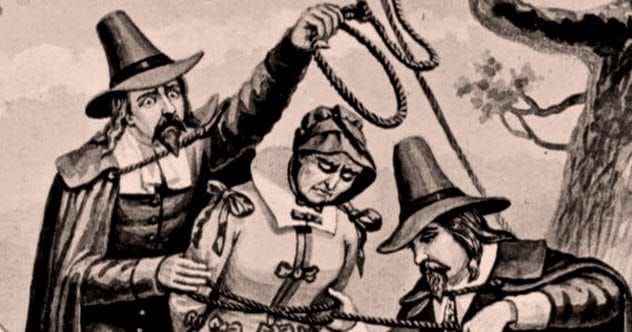Ever wondered what could brand a woman a witch centuries ago? It wasn’t always about dark magic or secret potions. Sometimes, the reasons were far more mundane, yet tragically twisted by fear, superstition, and local disputes. Prepare to delve into some truly mind-boggling and often heartbreaking reasons women faced accusations of witchcraft, situations that turned everyday occurrences or personal traits into death sentences.
10. Being Too Sick for Church
Today, staying home when you’re unwell is common sense. But in Puritan communities like the Massachusetts Bay Colony, things were quite different. Everyone was expected to attend church for hours, several times a day. Sarah Osburn, a resident of Salem, found herself in a tough spot. She had already stirred local gossip. She married her much younger indentured servant after her husband’s death. Then, she claimed her late husband’s property for herself, against tradition and his will which favored her sons.
When young Abigail Williams and Betty Parris, key figures in the Salem witch trials, accused Osburn of attacking them, her controversial past didn’t help. Locals also noted she hadn’t been to church in three years. Osburn, aged 49, explained she was very ill and mostly bedridden. She did admit to magistrates that a “lying spirit” once told her to avoid church. However, she insisted she had ignored the spirit and attended services until her illness prevented her. The magistrates weren’t convinced. They jailed her to await trial. Sadly, the grim conditions of Salem jail were too much for the already sick woman. Sarah Osburn died there after nine weeks, before her trial could even take place.
9. Appearing in Someone’s Nightmare
Could a bad dream lead to a death sentence? In 1661 Scotland, it certainly could. This period marked the last and deadliest wave of Scottish witch trials, particularly in the Lothian region. Beatrix Leslie, an elderly midwife from Dalkeith, Midlothian, fit the unfortunate profile of a target. She was old, known to be argumentative, and used folk remedies and rituals in her work.
Suspicions arose against Leslie when two young girls she had allegedly angered died. Soon after, a couple for whom she had worked as a midwife came forward with a chilling story. They claimed that after an argument with Leslie, they had violent nightmares. In these dreams, Leslie attacked and ate them. This kind of “spectral evidence” – visions or dreams of the accused – became a hot topic thirty years later in the Salem trials. Scottish tradition was even cited to support its use. For Leslie, her former clients’ nightmare testimony was enough. The infamous witchfinder John Kindcaid examined her, pricking her for the devil’s mark and forcing her to touch her victims’ corpses, which he claimed bled. Under this duress, Leslie confessed to meeting the devil and becoming his servant. She was executed a few days later, in September 1661.
8. Owning a Cat Named Satan
An unusual pet name might raise eyebrows, but could it make you a witch? In Chelmsford, England, in 1566, it seems it did. Elizabeth Francis, an elderly woman with a poor reputation, faced witchcraft charges three times before her execution. During her first trial, she confessed her grandmother gave her a cat as a child. This cat, she claimed, spoke to her, demanding drops of her blood as food. It supposedly helped her kill animals and people, and taught her to use herbs for an abortion after her lover got her pregnant.
Tragically, the man fell ill and died soon after Francis took the potion. She was accused of using the cat to kill him and found guilty. Remarkably, a clerical error meant she was jailed for a year instead of being executed. Her sister, Agnes Waterhouse, wasn’t so fortunate. Tried alongside Francis, Waterhouse was accused of receiving the cat, named Satan, from her sister, thereby inheriting magical abilities. The court claimed she killed her husband and sickened neighbors. Waterhouse admitted Pinstructing Satan to harm a neighbor’s animals out of curiosity but denied murder. Her 18-year-old daughter, Joan, also on trial, testified against her mother to save herself. Joan’s testimony sealed Agnes’s fate, making her the first woman executed for witchcraft in England.
7. Healing a Sick Child
Anna Goldi, a Swiss woman, is widely recognized as the last person executed for witchcraft in Europe. Her life was filled with hardship long before the accusations. She grew up poor, had two children out of wedlock, and lost one baby in infancy. Suspected of killing that child, she suffered public humiliation at the pillory. In 1780, Goldi began working as a servant for Johann Tschudi, a wealthy and high-status physician in Glarus. Trouble began when his children started finding pins in their food. Goldi was accused of trying to harm them and was fired.
Within a week, Tschudi’s young daughter became extremely ill; Tschudi later claimed she was vomiting pins. Goldi was brought back and accused of bewitching the child. Local belief held that only the person who caused such an illness could cure it. Under threat of torture, Goldi was ordered to heal the girl. Miraculously, the child’s health improved under Goldi’s care. However, this “proof” convinced her employer that she must have been the one to harm the girl initially. Anna Goldi was arrested, tortured, and eventually confessed to making a pact with the devil to harm the child as revenge. She was beheaded in 1782. A sad, lingering rumor suggested Tschudi and Goldi were lovers, and he faked the charges to prevent her from revealing their affair and ruining his reputation.
6. Being Identified as a Witch by a Child
Believe it or not, the testimony of children, who might believe in Santa Claus and fairies, was often not just accepted but actively sought in witch trials. The young “afflicted girls” of Salem, like Abigail Williams, are famous examples. However, successful accusations by children were not unique to Salem. Children were sometimes scared into saying what adults wanted to hear. Other times, they might accuse adults who had angered them, perhaps without fully grasping the deadly consequences.
Sweden, despite a relatively short history of witch trials, saw a major panic in the 1670s, leading to hundreds of executions. In the parish of Torsaker alone, 71 people were executed, all identified by children. This grim process, unfolding between 1674 and 1675, was led by Laurentius Hornaeus, a zealous priest. He instructed two young boys to stand outside the church and point out witches from the congregation. He told them witches had a special mark on their foreheads, visible only to children. The terrified boys did as they were told. Over the following months, many other children assisted Hornaeus, who wasn’t shy about using threats and torture to get accusations. Numerous children accused local women of kidnapping them for meetings with the devil. These hunts ended in a mass trial and execution, wiping out one-fifth of the parish’s female population.
5. Being in an Abusive Marriage
Bridget Bishop of Salem was known for being argumentative, not just with neighbors, but frequently and publicly with her husband. In Salem’s rigid society, this was a significant problem. Her husband, Thomas Oliver, was her second of three (a fact that also counted against her). He was widely considered abusive, and Bishop often fought back. Their disputes sometimes spilled out into public. Though neighbors testified to Oliver’s mistreatment of Bishop, both were seen as equally at fault.
After a particularly fierce argument on a Sunday, both Oliver and Bishop were ordered to pay a large fine or face a day in the pillory. Oliver’s adult daughter paid his fine, but Bishop endured the public shame of the pillory, cementing her bad reputation in Salem. When Thomas Oliver later fell ill and died, Bishop inherited his entire estate, leaving his children from his first marriage with nothing. Oliver’s children began to suspect Bishop had used witchcraft to kill him and seize his property. This was Bishop’s first official witchcraft accusation. Although found not guilty that time, her reputation suffered further. Over years, she was rumored to be a thief, a drunkard, and was criticized for her bright, showy clothing. Her troubled past and recent alleged misdeeds made her a prime candidate when the Salem witch trials began. She was swiftly found guilty and became the first person executed in the infamous trials.
4. Losing a Loved One to a Natural Disaster
On Christmas Eve in 1617, a terrible storm struck the seas around the tiny Norwegian village of Vardo. The town’s men, out fishing in a small fleet, all perished in the icy waves. The women, left grieving their husbands, sons, and brothers, had to fend for themselves. Vardo, located in the northernmost province of the Nordic Counties, was already viewed with suspicion by authorities. The harsh climate often blanketed the area in freezing mist and snow for months, feeding rumors that Hell’s entrance lay in a nearby mountain range.
The region was home to the indigenous Sami people, who were non-Christian and known for their folk magic. With Vardo’s men often away on long fishing trips, leaving women and children alone, the authorities now focused on this community surviving without men. They suspected witchcraft had caused the devastating storm. John Cunningham, a Scottish naval captain, was made Governor of Finnmark and tasked with launching a witch hunt from the Vardohus fortress. After interrogation and torture, Vardo resident Mari Jogensdatter confessed. She claimed she and other women conjured the storm as revenge for neighborhood disputes. Several women she named confirmed her story under torture, describing sabbaths with wine and the devil. Many pointed to their wealthy neighbor Kirsti Sorensdatter as their leader. Sorensdatter and Jogensdatter were burned at the stake, sparking Norway’s first major witch hunt. Ninety more women from the community met the same fate, but Vardo’s ordeal wasn’t over; it became the center of two more witch hunts that killed hundreds more.
3. Having Argumentative Male Relatives
Rebecca Nurse, at 71, was the oldest victim of the Salem witch trials, and an unlikely one at that. She was widely regarded as a devout and kind woman. Both she and her husband were respected members of the community in Salem town and village. However, their decision to move from Salem Towne to Salem Village, renting a farm from a local Reverend, unintentionally drew them into a heated land dispute among some of the area’s wealthier families.
The conflict centered on land between Salem Village and nearby Topsfield, with residents on both sides claiming ownership. Thomas Putnam and several of his brothers had settled on this disputed land. They were furious to learn that parts of it were being granted to Topsfield residents, including Rebecca’s brother, Jacob Towne. When Putnam’s daughter, Ann, one of the “afflicted girls,” claimed a witch tormented her, Putnam used her accusations to target the families of the Topsfield men. Rebecca Nurse was among his victims. Her family and neighbors rushed to her defense, providing character testaments. At her trial, she was initially found not guilty. However, after the afflicted girls reacted hysterically to the verdict, the jury was pressured to reconsider. They changed their verdict: Rebecca Nurse was found guilty and sentenced to death. Several other women from prominent Topsfield families, including Nurse’s sister Mary, were also executed.
2. Having Veins in Your Eye
Margaret Aitken, known as the “Great Witch of Balwearie,” was a peculiar figure in Scottish witch-hunting history. Arrested and accused of witchcraft in 1597, Aitken confessed. But she then made an astounding claim: she could not only name other witches she knew personally but also identify any witch, anywhere, simply by examining the pattern of veins in their eyes. The idea of a “devil’s mark” on a witch’s body was not new. However, finding it usually involved stripping victims, inspecting their entire bodies for suspicious marks, and pricking any found to check for lack of pain or blood. Aitken’s eye examination method was much quicker and seemingly more efficient.
The authorities, with enthusiastic backing from King James VI, organized a national tour. They paraded Aitken from town to town, lining up suspected witches for her ocular inspection. Anyone she identified was arrested and tortured into confessing. It’s unclear exactly how or why Aitken devised this scheme. Historians suggest she was terrified for her own life and was trying to buy time, or perhaps even escape execution by proving herself useful. In the few months before she was exposed as a fraud, Margaret Aitken was responsible for sending hundreds of women to their deaths. Once her deception was revealed, she too was executed.
1. Having a Witch Parent – Even as a Child
The third and final wave of the Vardo witch trials in Norway (1661–1662) gained horrific momentum through accusations against the children of women previously executed for witchcraft. Two sisters, Ingeborg Iversdatter, aged twelve, and Karen Iversdatter, aged eight, were brought to the Vardohus fortress for questioning in December 1662. Their mother had been burned as a witch only months earlier. With them was twelve-year-old Maren Olsdotter, who had lost both her mother and aunt in witch trials.
The children were confined in a cell on the estate known as the “witches’ hole.” Likely desperate for release, the girls gave detailed confessions. They described transforming into cats and traveling with other witches to a sabbath where they drank wine with Satan. Maren even claimed to have toured hell with an evil spirit. Although none of the girls could be executed due to their young age, their testimonies were instrumental in implicating adult women, most of whom were then tried and burned. The tide turned slightly when two accused witches provided witnesses stating the girls had been threatened with torture. The children were then denounced as liars. Maren, who had told the most elaborate tales, was sent to a workhouse, while the Iversdatter sisters were freed. This chilling episode shows how even children were not safe from the hysteria, targeted simply because of who their parents were.
The reasons women faced witchcraft accusations throughout history were often far from sensible. From social standing to simple misfortunes, these ten examples show how fear, superstition, and personal vendettas could lead to tragic ends. It’s a stark reminder of how vulnerable individuals were in times of mass hysteria.
What do you think is the most shocking accusation on this list? Share your thoughts in the comments below!










